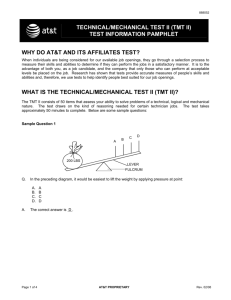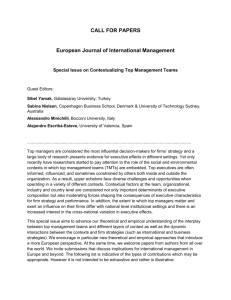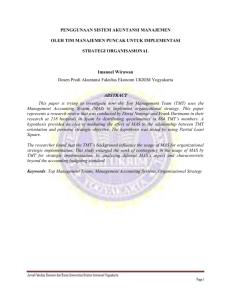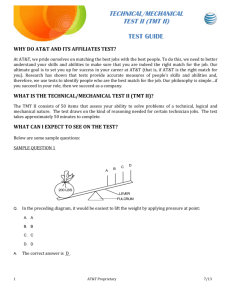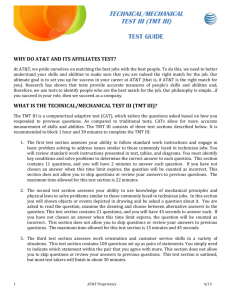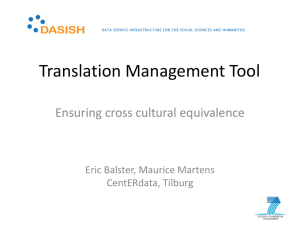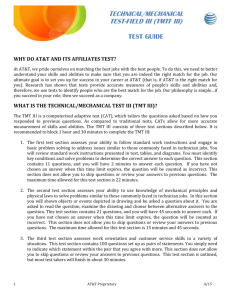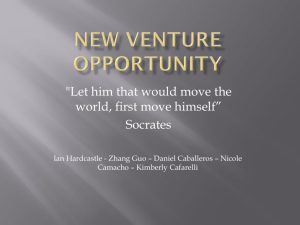T Recent Developments with the Thirty Meter Telescope System Science Capabilities Mark Dickinson
advertisement
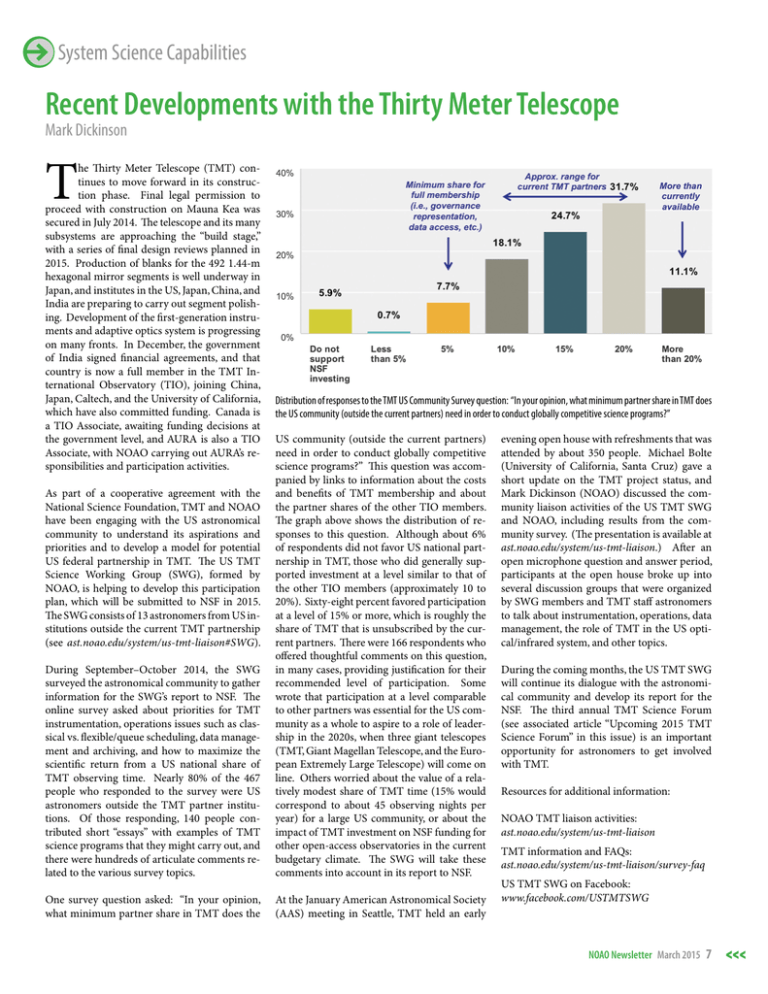
System Science Capabilities Recent Developments with the Thirty Meter Telescope Mark Dickinson T he Thirty Meter Telescope (TMT) continues to move forward in its construction phase. Final legal permission to proceed with construction on Mauna Kea was secured in July 2014. The telescope and its many subsystems are approaching the “build stage,” with a series of final design reviews planned in 2015. Production of blanks for the 492 1.44-m hexagonal mirror segments is well underway in Japan, and institutes in the US, Japan, China, and India are preparing to carry out segment polishing. Development of the first-generation instruments and adaptive optics system is progressing on many fronts. In December, the government of India signed financial agreements, and that country is now a full member in the TMT International Observatory (TIO), joining China, Japan, Caltech, and the University of California, which have also committed funding. Canada is a TIO Associate, awaiting funding decisions at the government level, and AURA is also a TIO Associate, with NOAO carrying out AURA’s responsibilities and participation activities. Distribution of responses to the TMT US Community Survey question: “In your opinion, what minimum partner share in TMT does the US community (outside the current partners) need in order to conduct globally competitive science programs?” During September–October 2014, the SWG surveyed the astronomical community to gather information for the SWG’s report to NSF. The online survey asked about priorities for TMT instrumentation, operations issues such as classical vs. flexible/queue scheduling, data management and archiving, and how to maximize the scientific return from a US national share of TMT observing time. Nearly 80% of the 467 people who responded to the survey were US astronomers outside the TMT partner institutions. Of those responding, 140 people contributed short “essays” with examples of TMT science programs that they might carry out, and there were hundreds of articulate comments related to the various survey topics. US community (outside the current partners) need in order to conduct globally competitive science programs?” This question was accompanied by links to information about the costs and benefits of TMT membership and about the partner shares of the other TIO members. The graph above shows the distribution of responses to this question. Although about 6% of respondents did not favor US national partnership in TMT, those who did generally supported investment at a level similar to that of the other TIO members (approximately 10 to 20%). Sixty-eight percent favored participation at a level of 15% or more, which is roughly the share of TMT that is unsubscribed by the current partners. There were 166 respondents who offered thoughtful comments on this question, in many cases, providing justification for their recommended level of participation. Some wrote that participation at a level comparable to other partners was essential for the US community as a whole to aspire to a role of leadership in the 2020s, when three giant telescopes (TMT, Giant Magellan Telescope, and the European Extremely Large Telescope) will come on line. Others worried about the value of a relatively modest share of TMT time (15% would correspond to about 45 observing nights per year) for a large US community, or about the impact of TMT investment on NSF funding for other open-access observatories in the current budgetary climate. The SWG will take these comments into account in its report to NSF. One survey question asked: “In your opinion, what minimum partner share in TMT does the At the January American Astronomical Society (AAS) meeting in Seattle, TMT held an early As part of a cooperative agreement with the National Science Foundation, TMT and NOAO have been engaging with the US astronomical community to understand its aspirations and priorities and to develop a model for potential US federal partnership in TMT. The US TMT Science Working Group (SWG), formed by NOAO, is helping to develop this participation plan, which will be submitted to NSF in 2015. The SWG consists of 13 astronomers from US institutions outside the current TMT partnership (see ast.noao.edu/system/us-tmt-liaison#SWG). evening open house with refreshments that was attended by about 350 people. Michael Bolte (University of California, Santa Cruz) gave a short update on the TMT project status, and Mark Dickinson (NOAO) discussed the community liaison activities of the US TMT SWG and NOAO, including results from the community survey. (The presentation is available at ast.noao.edu/system/us-tmt-liaison.) After an open microphone question and answer period, participants at the open house broke up into several discussion groups that were organized by SWG members and TMT staff astronomers to talk about instrumentation, operations, data management, the role of TMT in the US optical/infrared system, and other topics. During the coming months, the US TMT SWG will continue its dialogue with the astronomical community and develop its report for the NSF. The third annual TMT Science Forum (see associated article “Upcoming 2015 TMT Science Forum” in this issue) is an important opportunity for astronomers to get involved with TMT. Resources for additional information: NOAO TMT liaison activities: ast.noao.edu/system/us-tmt-liaison TMT information and FAQs: ast.noao.edu/system/us-tmt-liaison/survey-faq US TMT SWG on Facebook: www.facebook.com/USTMTSWG NOAO Newsletter March 2015 7 System Science Capabilities Upcoming 2015 TMT Science Forum Mark Dickinson T he TMT Science Forum is an annual opportunity for astronomers from the international TMT community to meet, collaborate, and plan for future TMT science programs. Attending the Forum is the best way to become informed about the status of the observatory, its instrumentation and adaptive optics system, and to get involved in shaping the future of TMT. The 2015 TMT Science Forum will be held on 23–25 June 2015 at the headquarters of the American Association for the Advancement of Science (AAAS) in Washington, D.C. The meeting theme is “Maximizing Transformative Science with TMT.” The registration deadline is 15 May 2015. With nine times more collecting area than a Keck telescope and 12 times better angular resolution than the Hubble Space Telescope (HST) in the near-infrared, TMT will enable amazing new science (see figure). The 2015 Forum is an opportunity to think about how to maximize the scientific return from TMT through innovative collaborations, telescope operations, data management, and instrumentation development. The meeting will feature presentations about truly transformative science that will be possible with TMT and focus on how Diffraction-limited imaging and integral field spectroscopy from TMT’s first-light instrument IRIS (Infrared Imaging Spectrograph) and the NFIRAOS (Narrow Field Infrared Adaptive Optics System) will resolve stars at the center of M31, measuring proper motions within the sphere of influence of the central, supermassive black hole as well as dynamics and stellar population properties. Left: A three-color image using the HST Advanced Camera for Surveys (F814W) and Wide Field Camera 3 (F110W, F160W). Right: A three-color image (J, H, and K bands) using TMT IRIS. The diffraction limited point spread function has full width half-maximum equal to 0.017 arcseconds at a wavelength of 2 microns. (Image credit: Dr. Tuan Do and the IRIS Science Team.) best to accomplish that science. There will be working sessions devoted to planning for possible TMT key programs that could span the international TMT partnership as a way to carry out projects that might exceed the capacity of individual scientists and teams within any single partner. The implications of such programs for TMT operations and the evolution of its instrumentation suite will all be discussed. The NSF-TMT cooperative agreement provides generous funding for members of the US community to attend the TMT Science Forum. Write to tmt@noao.edu for more information, and watch the Forum website (conference.ipac.caltech.edu/tmtsf2015), the NOAO Currents electronic newsletter, and the US TMT SWG Facebook page for more information. The 2014 NOAO and LSST Observing Cadences Workshop Knut Olsen & Steve Ridgway N OAO and the Large Synoptic Survey Telescope Project Office (LSSTPO) co-hosted a workshop on the LSST observing cadence during the week of 11–14 August 2014, in Phoenix, Arizona, in parallel with the larger LSST Project and Community Workshop. The cadence workshop drew more than 100 registrants, which included an even mix of Project people, non-Project scientists involved in LSST Science Collaborations, and people new to LSST. As described by LSST Director Steve Kahn in his introductory presentation, LSST is fundamentally a time domain facility, with a telescope, camera, and data management system designed to visit most of the southern sky one thousand times over the course of 10 years. However, the order of those visits—the cadence—has not yet been finalized; this represents an important opportunity for involvement by the open scientific community in the design of the LSST survey. The freedom to customize the cadence is constrained, however, by the need to serve a broad and ambitious science case. The scientific goals of LSST include identifying moving solar system objects, mapping the structure of the Milky Way, probing cosmology through multiple means, and characterizing the variable optical sky. Each of these science themes contains a large number of specific science cases, each case with potential desires for an optimal cadence. Optimizing the LSST cadence for these specific science cases, while ensuring that the broad continued 8 NOAO Newsletter March 2015 System Science Capabilities The 2014 NOAO and LSST Observing Cadences Workshop continued NL The participants of the NOAO and LSST Observing Cadences Workshop gathered on the first day of the meeting in Phoenix, Arizona. For additional information about the workshop, visit project.lsst.org/meetings/ocw/. goals of LSST are achieved, will require experimentation and quantitative analysis, for which the LSST Operations Simulator (OpSim) software will be a critical tool. In this inaugural cadence workshop, our primary goal was to establish basic quantitative input for specific science cases in the form of metrics that measure how well a given LSST cadence performs for that science. With such metrics in hand for all science cases, we can in the future compare the results of OpSim simulations employing different cadence logic and focus on those strategies that have the greatest benefit for the broadest and most compelling science. A secondary goal of the workshop was to identify promising avenues of future cadence strategy exploration. After a pre-workshop tutorial session on the Metrics Analysis Framework (MAF), a software package written to make it straightforward to code metrics and to apply them to OpSim simulation output, the workshop opened with a plenary session to provide background on the LSST continued NOAO Newsletter March 2015 9 System Science Capabilities The 2014 NOAO and LSST Observing Cadences Workshop continued Project and cadence. The subjects of these presentations included the process by which LSST will be scheduled, how LSST cadence simulations are performed, descriptions of key hardware and scientific constraints on the cadence, and the tradeoffs involved in choosing a cadence strategy. The workshop proceeded with a series of breakout group discussions on a variety of scientific topics, typically led by pairs of leaders. The bulk of the workshop activity occurred in these groups, which made excellent progress in generating ideas for useful metrics for compel- ling LSST science cases, identifying the ingredients of those metrics, and in several cases coding them using MAF. The groups also identified work that needs to be done by the LSST Project and the science community to make an optimized LSST cadence a reality. The groups contributed to a report of the workshop outcome, which can be seen at: project.lsst.org/meetings/ocw/. Stay tuned for news on the second Observing Cadences Workshop! NL TripleSpec4 Commissioning Planned for Semester 2015A David Sprayberry T ripleSpec4 will be the last new instrument built under the Renewing Small Telescopes for Astronomical Research (ReSTAR) award for NOAO. Construction of TripleSpec4 is a partnership between Cornell University (PI: Dr. Terry Herter) and NOAO; Cornell has engaged Dr. John Wilson (University of Virginia) to support the project. TripleSpec4 will be a moderate-resolution, single-object infrared spectrograph designed to support a broad range of science with a simple format, operational robustness, and the following principal features: • Simultaneous wavelength coverage of 0.8–2.4 μm • Reimaging fore-optics to match the telescope f-ratio to the instrument • Single, fixed collimator-disperser-camera unit (no moving parts) • Resolution of R ~ 3000 • Slit width of ~1 arcsec, slit length of 37 arcsec • Pixel sampling of 1 arcsec = 2.4 pixels • Integrated infrared slit viewer/guider with a field of view of approximately 4 × 4 arcmin TripleSpec4 Dewar (blue shell) and optical support structures (aluminum bulkhead walls) undergoing test-fit in the lab at Cornell prior to painting and final assembly. Saramoira Shields, a Cornell undergraduate assisting with the assembly work, stands next to the Dewar. The name of the instrument comes from the fact that three versions were planned originally. Two are in use: one on the Palomar Observatory 200inch Hale Telescope and a second on the Astronomy Research Consortium (ARC) 3.5-m telescope. The third is under construction at the California Institute of Technology (PI: Keith Matthews) for use on the Keck II telescope. The one for NOAO will be the fourth version, and it will be installed at the Cassegrain focus on the Blanco 4-m telescope at CTIO. stayed for the first round of full-system cool-down and performance tests. Everything currently remains on schedule for delivery to CTIO in March 2015, with first on-sky testing planned for April 1. TripleSpec4 is now in the final integration and testing phase at Cornell. The accompanying picture shows the Dewar and optical support structures during a test-fit prior to painting in early December 2014. Assembly work continued throughout January 2015, with optics installation during the second half of that month. NOAO staff in Chile, having completed the testing and optimization of the detectorcontroller subsystems, visited Cornell in early February to support the integration of the detectors into the nearly complete instrument and Because the first commissioning run will occur after the deadline for 2015B observing proposals, there will be no demonstrated on-sky performance information available to potential proposers. Therefore, the instrument will not be available for regular science proposals during 2015B, but should be available for 2016A. Depending on the progress of commissioning, there may be a special call for limited science verification proposals in 2015B at the discretion of the associate director for CTIO. 10 NOAO Newsletter March 2015
